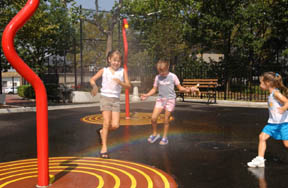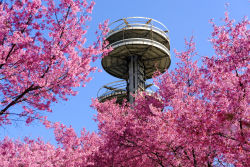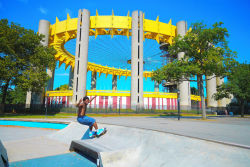Flushing Meadows Corona Park
The Daily Plant : Tuesday, March 4, 2003
THE PREVIOUS LIVES OF PARKS
Photo of Frontera Park by Spencer T Tucker
Many of us have wondered how our souls were occupied in previous lives, but even the best psychics cannot definitively prove that we once lived as a pampered housecat, heroic soldier, or famous inventor. Fortunately, it is much easier to determine how the city’s parks were used in previous generations. It’s common knowledge that Washington Square Park was once a cemetery, that City Hall Park was once used for grazing animals and that Flushing Meadows-Corona Park was a gigantic ash dump. Some parks even take their names from their previous uses. Asphalt Green, for example, was once the site of an asphalt plant. For parks whose previous lives are more mysterious, our historic signs offer the full story. Today, The Daily Plant takes a random sampling of some of the previous lives of parks. You may be shocked to find out how your favorite parks were once used…
Some parks have been built on land that has always been used for fun and leisure. Bellaire Playground was once known as "Interstate Park" and was the home of a shooting gallery and casino. Owned by the National Pigeon Shooters Association, the park proudly hosted the largest annual trapshooting competition until 1902, when live target practice fell out of favor. Oriental Boulevard Malls run through an area known for its entertainment. At the turn of the 20th century, this section of Brooklyn was a remote vacation spot with three nearby racetracks. Oriental Boulevard Malls were named after the Oriental Hotel that once stood at the eastern portion of Coney Island. There were also once racetracks in Rochdale Park and Loreto Playground. The Luna Park Houses stand on the site of an amusement park of the same name, and there was a bowling alley and catering hall in Joe Holzka Community Garden. Not surprisingly, many public parks were once private parks. Fort Hamilton Athletic Field was the site of the Crescent Athletic Club and Walker Park was once the Staten Island Cricket and Tennis Club.
Other parks were once used for more practical purposes. Liotti-Ikefugi Playground was a reservoir, as was Strong Street Playground and Central Park’s Great Lawn. Driscoll Tucker Place was built on top of a sewer pipe, and Underhill Playground, in Kissena Corridor Park, was built over a storm sewer. A police station once stood on the land the site that is now known as Ramon Aponte Playground. (Legend has it that Mae West was brought to that police station when arrested for her 1926 play, Sex.) Skyline Park was built where P.S. 17 used to stand, and the Dreier-Offerman Home for unwed mothers and their children once stood on a portion of Calvert Vaux Park. Frontera Park was home to the Maspeth Bus Garage, and Playground 96 famously contained a massive car barn, which held the cars of the Second Avenue Railway.
Because we live in New York, one of the oldest cities in the country, almost all of our parks have a colorful past. So, the next time you sit on a park bench, or take a walk through a city-owned garden, consult the historical sign or find it online and consider all the things that might have happened on that very same spot over the past three hundred years-- a man might have lost his life savings gambling on a horse; a bumper crop of corn might have saved a farmer from bankruptcy; a woman might have given up her baby for adoption; or a child might have learned how to do long division. If you’re curious about the years before New York was a city, or even a sparkle in the eyes of European settlers, you’ll have to wait for the second installment of "Previous Lives" of parks, when we consult the natural history of parks: the very first—and wildest—lives.
Written by Hannah Gersen and John Mattera
QUOTATION FOR THE DAY
"There is history in all men’s lives."
William Shakespeare
(1564-1616)












